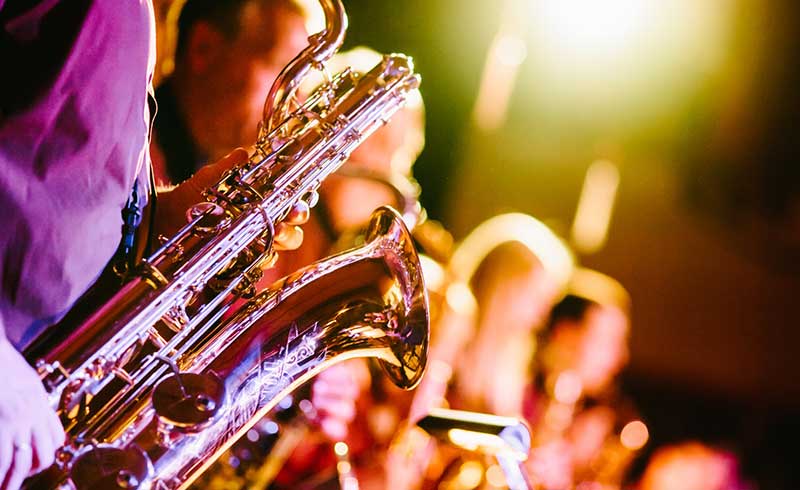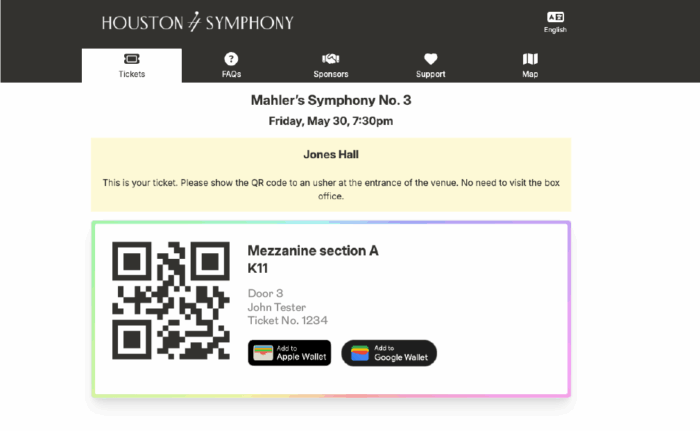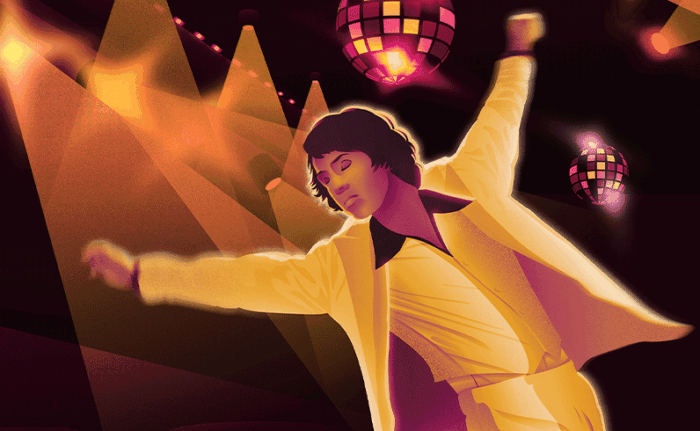Classical musicians often hear the question, “What do you listen to in your spare time?” Sheldon Person, viola, shares this notated playlist of a few of his jazz favorites.
As we all have recently, I’ve found myself working from my home office more than usual. This time has given me an opportunity to spend some energy on an old interest for me, jazz, both as an inspiration for my own creative work, and also some mental and acoustic “ear” freshener. These are some of my favorite tracks from my home library, so here’s my 11-song jazz playlist (also available on Spotify).
This is a hobby for me, and I’m not an expert, but I’ve written some notes on each track. I really believe that actually paying attention to music is where you’ll find the magic, and that’s where these notes are designed to point you. Think of it this way: I can go to the Grand Canyon, snap a photo, maybe put it online, and leave, and that’s ok, there’s nothing wrong with that. But what if I put my phone away and pay attention to where I am, just for ten minutes? What happens in that space?
The musicians and performances on this playlist are by some of the greatest musicians who ever lived, sort of the top 0.01%. Listening to this music is like seeing the world from Everest. There’s nothing wrong with turning it on and listening in the background, I do that too. But if you can spend even ten minutes really listening, that’s where you’ll strike gold. If you have an interesting interaction with the music, in return, that’s your gift to me. Thanks in advance.
1. “West End Blues” by Louis Armstrong & His Hot Five (1928)
This track just seems like the best place to start. Louis Armstrong was an innovator and a giant of jazz. This track is early New Orleans style in a nutshell. The first 13-second trumpet solo is legendary—what an opening statement. Notice the duet at 1:23 of this track: Louis is “scat” singing. Remember this, we’re going to come back to it later. That duet with the clarinet is a “call-and-response.” Think: Southern churches and African-American spirituals. Armstrong didn’t invent “call-and-response”; he just uses it poetically in a jazz setting. This is jazz: a mixture at heart.
2. “Oh, Lady Be Good” by Count Basie & the Kansas City Seven (1962)
Kansas City isn’t just about BBQ—it was one of the major early centers of jazz as it grew out of New Orleans. This track is so light and easy: it whispers “cool.” I love how Basie (piano) uses silence to create drama during the first two minutes of this track. He can play really fast, and occasionally he does, but the rests are where the magic is. The part that always makes me smile is 1:22–1:26. He is playing the song here (originally composed by George Gershwin), but he’s doing almost nothing at the same time. Lean, abstract, and really hip. Now go back and listen to the first 9 seconds: see what he’s doing? He’s playing around with this 2-note idea from the introduction, and he puts that idea back (1:22) into the first theme or the “head.” Jazz musicians are performing and improvising in real-time, and this means they’re also composing on-the-fly. Here we have a composer at work in real-time. Cool.
3. “Afternoon in Paris” by Stéphane Grappelli (1971)
String players are outliers in jazz, but I had to include one. And there’s one string jazz player who towers above them all: violinist Stéphane Grappelli. Grappelli came into his own in Paris in the 1920s and 1930s. While jazz evolved around him throughout the 20th century, the newer styles were never his thing, and good for him: his thing was completely unique and authentic. As you can hear in this song, though he could play so fast and virtuosically, it always sounds effortless, suave, kind of French, and most of all fun. There’s never a dark cloud in the sky when he plays. I love this song. It’s an incredibly singable tune that I catch myself singing over and over without realizing…
4. “Confirmation” by the Charlie Parker Quartet (1953)
Here’s a famous song by another jazz giant, Charlie Parker. It’s impossible to overstate Parker’s influence in jazz: there was before him and after him. As you can hear, we’re in a different world from that of the first three songs. Called “bebop,” this style was sort of the beginning of modern jazz. We’re in “Lisa Simpson” territory now.
I love Charlie Parker’s playing. He lived extremely hard and suffered a lot, and his music has a hard-swinging, hard-driving quality. Listen to this track: there’s nothing light or relaxed about it. But while it’s hard-edged, I find it paradoxically elegant. There are some musicians who can just play faster than I can think, and he’s one of them.
As a more advanced note, listen to Parker’s phrasing from 0:44 to 2:00, during his first two improvised choruses. Like Basie, he also uses silence frequently to punctuate his thoughts. But he’s also phrasing over bar lines and even over harmonic sections. For instance, at 1:50, the harmony changes back to the A section, but Parker is still finishing up the last phrase from the B section. This is just one example—he’s doing it everywhere. It’s not easy to do, and he’s amazing at it. His nickname was “Bird,” and the image of his playing is flight. It’s imaginative, flawless, and breathtaking.
5. “Celia” by Bud Powell (1949)
Another tortured soul of jazz, Bud Powell was a pianist for the ages. With a similar style to that of the one we just heard, Powell was sort of the Charlie Parker of the piano. Check out the solo break at 1:09–1:13. In addition to the virtuosity of it, what an interesting collection of notes—cool and beautiful.
There are other pianists of this era who are maybe more household names, but I picked this track because of all the songs I love on this playlist, this is my favorite one. Apparently, Powell got let out of the psych ward at the hospital to record this session, on the promise that he would be back by dinner—unreal. This song was named for Powell’s daughter Celia. What I love about this tune is that it’s charming but never cute, and tender without being sentimental. It’s a magical jewel of a song that I’ve been singing it to myself all day. I can’t get it out of my head.
6. “Bloomdido” by Charlie Parker & Dizzy Gillespie (1950)
Here’s another incredibly catchy song that’s been following me around from room to room this week. Composed by Charlie Parker, this time drawing upon his Kansas City roots with the 12-bar blues. He’s joined here by jazz legends Dizzy Gillespie and Thelonious Monk. Compare this song to “West End Blues,” which is also a 12-bar blues. In 22 short years, this art form is on a completely different planet now. For one thing, the tempo is almost three times as fast as Armstrong’s blues. Parker and Gillespie also repeat the 12-bar form almost three times more than Armstrong does in basically the same length of track: more speed, more notes, more harmonies, more content, just more. Side note: the album artwork (shown in this YouTube video) is brilliant: that’s Dizzy facing us with the trumpet and Bird in profile with the sax.
7. “It Don’t Mean a Thing” by Stan Getz & Dizzy Gillespie (1953)
In this famous “standard,” Dizzy is joined by Stan Getz (best-known as the velvety-toned sax player on “The Girl from Ipanema”) and Oscar Peterson. I like this track because it gives a little glimpse into the accidental magic of live performance. Jazz is an improvised art form; the performers are improvising solos over a set harmonic sequence, or “changes.” But they’re not composing every note out of whole cloth; think more of speaking a language and having a conversation. They are composing, but composing within an established framework.
Form is easy to comprehend in the visual realm. But music has form also, it’s just harder to grasp because it’s invisible and it also exists in time. Like visual form (and mechanics!), musical form is made up of component parts. Music may seem like “pretty sounds that begin and end,” but there’s really a road map, a form, that gets us from beginning to the end. I know, you’re thinking: “Next thing you’re gonna tell me is that magicians in Las Vegas aren’t doing magic at all!” Exactly.
In this track, listen to the first 20 seconds. This is the introduction. Hear that circling bit played over and over? Remember that. Now at 0:21–0:43, we have the tune, “It don’t mean a thing…” After this, the musicians take turns playing improvised solos. Spoiler alert: they’re 32 bars each (I know somebody reading this will find this joke hilarious).
Now something cool happens at the end. Normally, jazz standards end the way they begin, with the theme or “head.” This is what Getz is expecting. Listen at 6:07, Getz starts playing the tune from 0:21. But then Dizzy comes right in with a different idea, he’s playing the circling bit from the intro. Just by playing that, Dizzy is saying to Getz, “Let’s end this with the intro instead of the head.” And Getz is listening (insert “Getz” pun here), and he jumps on board with Dizzy right away. Who knows why Dizzy wanted to end the song this way, maybe he just wanted to get it over with, or maybe he thought it would be a cooler thing to do? I have no idea, but it sounds like Getz didn’t know either. And this all happens between 6:07 and 6:12. This is chamber music conversation and composition, happening in real-time, and this confusion all gets sorted out in five beautiful, accidental seconds. Who knows what jazz “is,” but whatever it is, you can hear it right there.
8. “Mack the Knife” by Ella Fitzgerald (1960)
Houston Symphony Principal POPS Conductor Steven Reineke mentioned this song at a POPS concert recently, and I’ve included this track as a kind of PSA. It absolutely deserves a listen. Ella was performing in West Berlin and decided she wanted to sing this song. Originally by German composer Kurt Weill, “Mack the Knife” was popular at the time because of the Bobby Darin hit. Ella herself says before the song starts at 0:14, “We hope we remember all the words.”
There are legends around Ella’s lack of discipline about learning lyrics, and maybe that’s exactly what happens here: let’s take her at her word. At 1:40 the magic begins. What Ella does from here, in this moment, in this performance, is better than any lyrics that anyone could have written for her. This performance won her two Grammys. Listen to what she says at 2:56–3:02, some hilarious self-awareness. And remember back in “West End Blues,” I said pay attention to the scat singing at 1:23? Well, check out 3:03–3:31. Not a bad impression, right? Creative, improvised, magical. What a musician, and what a performance.
9. “Flamenco Sketches” by Miles Davis (1959)
Compared to “Confirmation” six years earlier, we’re on a different planet again. The world is speeding up, and so is the evolution of jazz. This track is from Miles Davis’s album Kind of Blue, maybe the most famous jazz album in history. Everything here is about simplicity, brevity, and tone, even just the basic sound of the instrument itself. This is my favorite track of this album. Listen to the first two notes of this track in the double bass. Now notice when Miles comes in at 0:18—hear how he also just plays two notes and stops? I can’t imagine that’s a coincidence. Those two notes become the framework for his entire solo. Simple and beautiful.
Listen to the music before and after 1:09 and again at 2:50. Listen to how it feels to cross those thresholds. Do you hear how when you pass through this moment and into a new section, it doesn’t just sound like we’re in a different place, but almost a different country? Flamenco Sketches, get it? A stunningly intimate, beautiful performance: legendary.
10. “My Man’s Gone Now” by the Bill Evans Trio (1961)
Bill Evans was also the pianist in “Flamenco Sketches.” Compare his playing with Bud Powell’s: completely different, right? Notice also the cymbals from :00 to 0:29. Flip back to the beginning of “Bloomdido”: see how different that is? Jazz drumming has gone from keeping the beat to adding a wash of color and intimacy. Of additional note, this is the only song on this playlist that’s in 3, not in 4. Bill Evans did love a waltz.
https://www.youtube.com/watch?v=P8HEl093bAE
11. “52nd Street Theme” by the Oscar Peterson Trio (1956)
If Bill Evans is Debussy, then Oscar Peterson is Liszt. Like Charlie Parker, Oscar is another musician who can play faster than I can think. Peterson is from Montreal, and for me growing up in Canada, he was always considered one of our great Canadians. He was sort of the Wayne Gretzky of jazz piano, playing entirely in his own league. Peterson learned the piano because he had tuberculosis as a boy; he couldn’t continue to play the trumpet, so he played the piano like Dizzy Gillespie instead.
The story of how he was discovered strikes me as hilariously Canadian. After the second world war, jazz impresario Norman Granz heard Oscar’s playing on the radio while he was in a cab in Montreal, and he arranged to meet him. When he offered to bring Oscar to play at Carnegie Hall, Oscar basically said that he wouldn’t go because he wasn’t good enough yet, and he had to go home and practice. Granz wouldn’t take “no” for an answer, and a legend was born. The story is funny now: there are so many great, unique voices in jazz, legends in their own right, but who could ever play the piano better than Oscar Peterson?
Jazz evolved around Oscar during the 20th century, but like Grappelli, Oscar just kept playing his own style. It kind of makes sense to me: why experiment with synthesizers or electronica when you can play the piano like that?
I picked this track for its sheer speed and virtuosity. He’s playing with two guys who could keep up, and they’re all flying. Remember “call and response” from “West End Blues?” Listen to 0:15–0:18 and 3:25–3:30. Same thing, just evolved and at warp speed. And I’m pretty sure that’s Oscar singing throughout this track. Awesome. What a legend.
You can also listen to the full playlist on Spotify. Enjoy!



